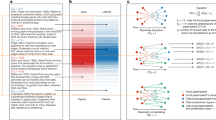Abstract
The size distribution of the domains of US-patented technological knowledge obeys an exponential law, revealing a disproportionable concentration of progress among larger domains. Our analyses suggest that this phenomenon is explained by a combination of two factors. First, domains’ trajectories of growth have inherently different potentials. Second, differences in domains’ potentials are magnified by a mechanism—domains’ self-hybridization—endogenous to the process of knowledge growth. Our results show that in addition to being stable, the observed distribution of technological progress is likely to arise under very general conditions.
Similar content being viewed by others
References
Albert R, Jeong H, Barabasi A-L (1999) Diameter of the world-wide web. Nature 401: 130–131
Anselin L (1998) Spatial econometrics: methods and models. Kluwer Academic Publishers, Dordrecht
Breusch T, Pagan A (1980) The Lagrange multiplier test and its applications to model specifications in econometrics. Rev Econ Stat 47: 239–253
Carnabuci G (2010) The ecology of technological progress: how symbiosis and competition affect the growth of technology domains. Soc Forces 88: 2163–2187
Carnabuci G, Bruggeman JP (2009) Knowledge specialization, knowledge brokerage, and the uneven growth of technology domains. Soc Forces 88: 607–641
Dosi G (1982) Technological paradigms and technological trajectories. Res Policy 1982 11: 147–162
Gabaix X (1999) Zipf’s Law for cities: an explanation. Q J Econ August:739–767
Gilfillan SC (1930) Inventiveness by nation: a note on statistical treatment. Geogr Rev 20(2): 301–304
Griliches Z (1957) Hybrid corn: an exploration in the economics of technological change. Econometrica 25: 501–522
Griliches Z (1984) R&D, patents, and productivity. University of Chicago Press, Chicago
Hall B, Jaffe A, Trajtenberg M (2001) The NBER patent citations data file: lessons, insights and methodological tools. NBER, Cambridge
Harberger AC (1988) A vision of the growth process. Am Econ Rev 88: 1–32
Henderson R, Jaffe A, Trajtenberg M (2005) Patent citations and the geography of knowledge spillovers: a reassessment: comment. Am Econ Rev 95: 450–460
Jaffe A, Trajtenberg M, Fogarty MS (2000) Knowledge spillovers and patent citations: evidence from a survey of inventors. Am Econ Rev 90(2): 215–218
Kesten H (1973) Random difference equations and renewal theory for products of random matrices. Acta Math 131: 207–248
Levy M, Solomon S (1996) Power-laws are logarithmic Boltzmann laws. Int J Mod Phys C 595: 65–72
Liljeros FL et al (2001) The web of human sexual contacts. Nature 411: 907–908
Lotka A (1926) The frequency distribution of scientific productivity. J Wash Acad Sci 16: 317–323
Merton RK (1968) The Matthew effect in science. Science 159: 56–63
Mitzenmacher M (2004) A brief history of generative models for power law and lognormal distributions. Int Math 2: 226–251
Mokyr J (2002) The gifts of Athena: historical origins of the knowledge economy. Princeton University Press, Princeton
Nelson RR, Winter SG (1977) In search of a useful theory of innovation. Res Policy 6: 36–76
Nelson R, Winter S (1982) An evolutionary theory of economic change. Belknap Press of Harvard University Press, Cambridge
Pareto V (1897) Cours d’economie politique. F. Rouge, Lausanne
Price DDS (1980) A general theory of bibliometric and other cumulative advantage processes. J Am Soc Inf Sci Technol 27: 292–306
Romer PM (1994) Economic growth and investment in children. Daedalus 123: 141–154
Rosenberg N (1976) Perspectives on technology. Cambridge University Press, New York
Rosenberg N (1994) Exploring the black box: technology, economics, and history. Cambridge University Press, New York
Scherer FM (1965) Firm size, market structure, opportunity and the output of patented innovations. Am Econ Rev 55: 1097–1125
Schmookler j (1966) Invention and economic growth. Harvard University Press, Cambridge MA
Simon HA (1955) On a class of skew distribution functions. Biometrika 42: 425–440
Simon HA, Bonini CP (1958) The size distribution of business firms. Am Econ Rev 4: 607–617
Usher AP (1954) A history of mechanical inventions. McGraw-Hill, London
Weitzman ML (1998) Recombinant growth. Q J Econ 113: 331–360
Zipf GK (1949) Human behavior and the principle of least effort. Addison-Wesley Press, Cambridge
Author information
Authors and Affiliations
Corresponding author
Rights and permissions
About this article
Cite this article
Carnabuci, G. The distribution of technological progress. Empir Econ 44, 1143–1154 (2013). https://doi.org/10.1007/s00181-012-0586-0
Received:
Accepted:
Published:
Issue Date:
DOI: https://doi.org/10.1007/s00181-012-0586-0




